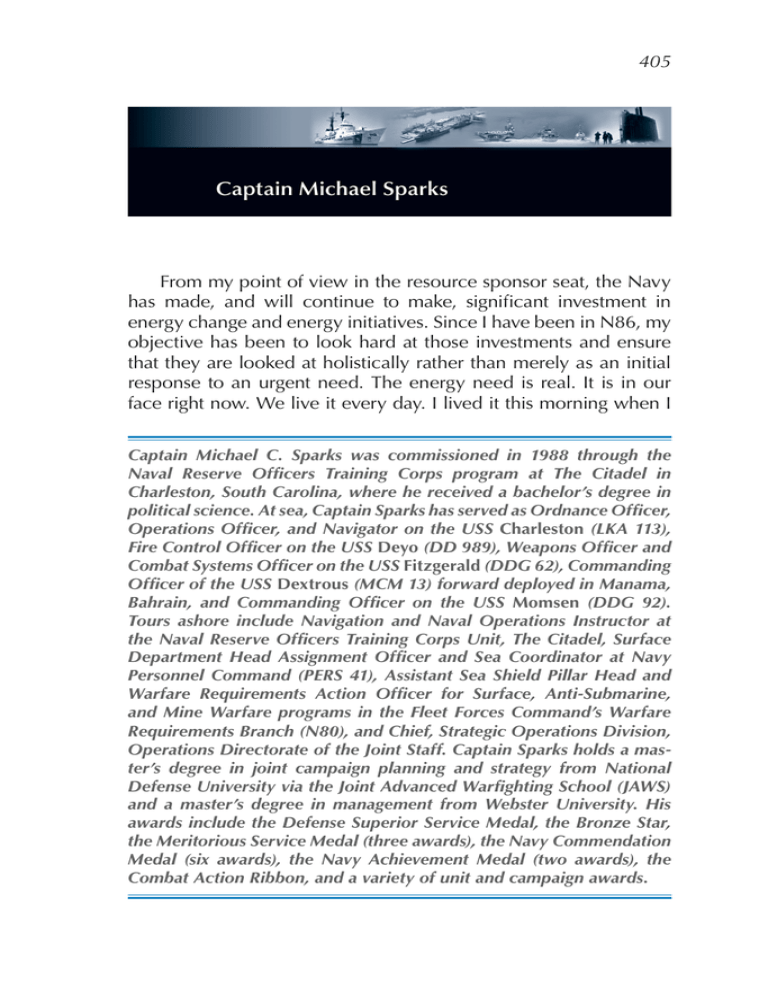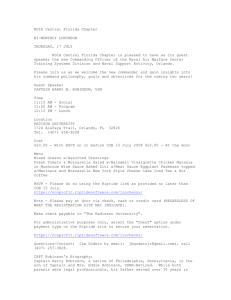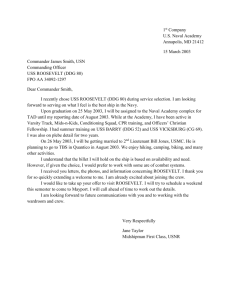Captain Michael Sparks
advertisement

405 Captain Michael Sparks From my point of view in the resource sponsor seat, the Navy has made, and will continue to make, significant investment in energy change and energy initiatives. Since I have been in N86, my objective has been to look hard at those investments and ensure that they are looked at holistically rather than merely as an initial response to an urgent need. The energy need is real. It is in our face right now. We live it every day. I lived it this morning when I Captain Michael C. Sparks was commissioned in 1988 through the Naval Reserve Officers Training Corps program at The Citadel in Charleston, South Carolina, where he received a bachelor’s degree in political science. At sea, Captain Sparks has served as Ordnance Officer, Operations Officer, and Navigator on the USS Charleston (LKA 113), Fire Control Officer on the USS Deyo (DD 989), Weapons Officer and Combat Systems Officer on the USS Fitzgerald (DDG 62), Commanding Officer of the USS Dextrous (MCM 13) forward deployed in Manama, Bahrain, and Commanding Officer on the USS Momsen (DDG 92). Tours ashore include Navigation and Naval Operations Instructor at the Naval Reserve Officers Training Corps Unit, The Citadel, Surface Department Head Assignment Officer and Sea Coordinator at Navy Personnel Command (PERS 41), Assistant Sea Shield Pillar Head and Warfare Requirements Action Officer for Surface, Anti-Submarine, and Mine Warfare programs in the Fleet Forces Command’s Warfare Requirements Branch (N80), and Chief, Strategic Operations Division, Operations Directorate of the Joint Staff. Captain Sparks holds a master’s degree in joint campaign planning and strategy from National Defense University via the Joint Advanced Warfighting School (JAWS) and a master’s degree in management from Webster University. His awards include the Defense Superior Service Medal, the Bronze Star, the Meritorious Service Medal (three awards), the Navy Commendation Medal (six awards), the Navy Achievement Medal (two awards), the Combat Action Ribbon, and a variety of unit and campaign awards. 406 Climate and Energy Proceedings 2011 filled my gas tank up before driving up here for the meeting. Given the billions of dollars that we spend on fuel, any savings that we can make at sea is an immediate return on investment. Still, that return on investment needs to be something that is sustainable for the long term. What does that mean? That means ensuring that systems—be they backfits, new procurement, or new construction—include the entire tooth-to-tail thought process. We do not want to put systems on ships to save money if we cannot sustain those systems. The logistics train needs to be there. The training for our operators has to be there. The technical support and backup has to be there so that when those systems break, we can repair or replace them. We have to be able to reach the tech community so that they can conduct the repairs. In short, we have to ensure that these systems continue to provide that return on the initial investment. In making those investments, we have to live within the existing requirements and acquisition process. While we are trying to change that process so that it does a better job of recognizing energy consumption and energy efficiency from the get go, we have to work within that process to achieve the desired end state. The desired changes are not things that you can just push a button and make happen. Such factors are, however, important enough that we should try to ensure that they are somehow considered in the system that we have today and fundamental to the process that evolves over the long term. I want to touch on the culture change topic that Rear Admiral Philip Cullom mentioned in his presentation. I think it is clear that investments in material solutions to help save energy are coming. Within the next year or two, proofs of concept will be coming into the fleet. After that, these solutions will appear in larger numbers as we go into the Green Fleet demo in 2016. Beyond that, we will have backfits to install hybrid electric drive on destroyers and the injection of the various technologies for renewable energy solutions, particularly fuels. The only drawback to this schedule is that it includes a gap, and that gap starts now. To be factually correct, I should say that the gap started about 10 years ago, but we will just take it from right now. Thus, until such time as when we have Chapter 12 Adapting to Climate and Energy Challenges 407 a fleet of sailors who know nothing but the energy conservation capabilities that exist within the fleet, we will have to rely heavily on that culture change piece that Rear Admiral Cullom talked about. That is huge. It is easy to say that we will just change the way we think, but the change is not just a change at the shipboard level. It is not just that the commanding officers of our ships have to drive differently. For the past 60 years, we have focused exclusively on combat capability; we all aspire to be 32-knot Burke. We want capability to go fast. We want speed to station. That thought process still needs to be there, and that capability still needs to be there when necessary, but now we need to consider the energyrelated aspects associated with properly planning and executing our operations not only at the shipboard level, but also at the numbered fleet level. That thought process has to be infused. When appropriate, we need to adjust our transit speeds to enable our ships to be more energy efficient. Our tactics, techniques, and procedures need to reflect those kinds of thought processes. In addition, we have to look at how we can infuse energy conservation into our risk management thought processes when we operate our ships. This is not to say that our ships should not have all their engines online when they are going alongside the oiler, but if a ship is getting under way from San Diego and it is a crystal clear day, there is no wind, and several tugs are on hand to pull the ship off the pier, is it really necessary to have four main engines, two generators online, and a third generator on standby? Operating that way burns a lot of fuel over the 3- to 4-hour period that it takes to get under way. Do we really need to do that? Our risk-averse side says: “Hey, I need to have the others available just in case that generator drops offline or that engine drops offline.” But remember, the ship still has two shafts. It still has two engines that can start quickly. So, what I am saying is that we need to provide opportunities for our commanding officers to consider energy conservation when they conduct their risk assessment along with everything else that goes into ship operations. It needs to become part of our culture at all levels of command. 408 Climate and Energy Proceedings 2011 Lastly, I will touch briefly on climate change. This past year, N86 sponsored a Naval Sea Systems Command study that takes a hard look at the changes we need to make in our systems in order to be able to operate effectively in the Arctic. The lessons learned from port are all very good and sound and are going to be included in the study. However, we need to go deeper; we need to go a lot deeper. We need to look hard at what the Canadians and some of our European allies do because they operate more frequently in the Arctic than we do. We need to see if they have already identified concepts that we could adapt to enhance our capability to operate in the Arctic as that mission set expands in the years to come. We do not want operations in the Arctic to be a crisis. Hopefully, we have time available now to investigate those issues and then implement any necessary changes so that when we need to operate in the Arctic, we will be ready to do so.



